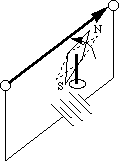
"The good effects wrought by founders of cities, law givers, fathers of the peoples, extirpators of tyrants, and heros of that class, extend but for short times; whereas the work of the Inventor, though a thing of less pomp and show, is felt everywhere and lasts forever." Francis Bacon, 16th Century
Electron: Greek word for amber (petrified tree sap).
1500 AD: word is used to create words like "electric" and "electrify." When amber is rubbed, it exhibits an attractive force -- static electricity. Electricity is built up and then discharged by a spark. Other example of attractive forces: glass.
Electricity: the "fluid" responsible for this attractive force. Could be seen in sparks.
Magnetism: known in ancient China. Lodestone -- natural magnet, used as a compass to assist navigation.
Critical inventions needed to enable the electric telegraph: insulated wires, batteries, and fundamental knowledge about electromagnetism such as the ability of an electrical current to cause a needle to deflect, electromagnets, etc.
1779: Chair of Physics at Padua University
Volt: the unit of electrical potential ("electromotive force").
Discovered that metals are "movers" of electricity. Arrange metals in an electromotive series based on their ability to gain or lose positive charges by contact.
Allowed steady flow of electricity instead of amber's electro-static build-up. An early example of "infrastructure" that made it possible for many others to experiment with electrical phenomena.
Voltaic pile: dissimilar metals separated by membranes moistened by acid -- the electric battery.
1804: Professorship at the Ecole Polytechnique in Paris
Amp: the unit of electrical current ("velocity of electrical flow")
Demonstrated the magnetic effects between two current carrying wires are the same as those between a wire and magnet.
Electrodynamics: mechanical forces between current-carrying conductors -- critical for the design of telegraph apparatus, telephone receivers, and loud speakers.
Ohm: the unit of electrical resistance
1817: Readership at the University of Cologne
I = V/R : the fundamental relationship between voltage (aka electromotive force), current, and resistance ("Ohm's Law")
Philosophical view that all of the forces of nature, i.e., light, electricity, magnetism, gravity, are variations on one basic source. Discovered that magnetic field exist around a current carrying conductor. A deflecting force, such as magnetism, was something completely new (attracting forces like gravity were already well known). Strong connection between electricity and magnetism. Demonstrated this effect with the deflection of a magnetic compass needle.
1806: Professor of Physics at the University of Copenhagen
1820: Chance observation of needle deflection during a class lecture!

Would have a profound impact on inventors attempting to build an early electric telegraph.
Farad: the electrical unit of capacitance (stored electrical charge).
Built on Oersted's observation of the deflecting needle. Demonstrated the electric motor: wire carrying a current rotated around a fixed electromagnet. Magnet stuck upright in mercury, current carrying wire suspended above magnet with one end in mercury. Wire rotates around the magnet. Also showed how to make a magnet rotate around a wire.
On his discovery of the principle of electromagnetic induction:
Politician: "But what's the use of it, Mr. Faraday?"
Michael Faraday: "Ah, but what use is a baby?"
Induction:
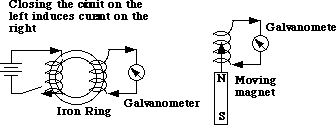
The fundamental law of electromagnetism:
Whenever a closed conductor moves near a magnet in such a manner as to cut across magnetic lines, an electric current flows in the conductor.
Two groups of electromagnetic phenomena:
Built on work of Volta, Faraday, Oersted. Signaling by means of electrical current along a conducting wire.
Basic idea: deflect a needle by connecting/disconnecting a battery to a wire. By alternating the connection between the + and - poles of the battery, the deflection could be enhanced: needle reverses its swing.
Russian Baron Schilling, late 1820s: deflecting disk, one side white one side black, swings from edge on. Single show of black edge = E, single show of white = T, Black followed by White = A, Two Blacks = I, Two Whites = S, White followed by Black = N, and so on. Remarkably like Morse's code!

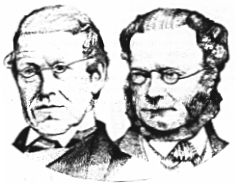 Charles Wheatstone
(1802 - 1875) and William Fothergill Cooke (1806 - 1879)
Charles Wheatstone
(1802 - 1875) and William Fothergill Cooke (1806 - 1879)Wheatstone was Professor at King's College London. Cooke was seized with the idea of making a commercially practical telegraph system based on the needle galvanometer. Joined forces in 1837.
Their system: 5 magnetic needles, deflected in pairs, selecting one of 20 letters of the alphabet. Original system required 5 wires. Later reduced to 2 by using coding techniques. 20 km of line installed along railway routes in 1838. Grows to 4000 miles by 1852.
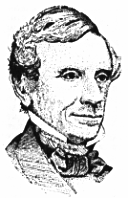 Samuel F. B. Morse (1791
- 1872)
Samuel F. B. Morse (1791
- 1872)Well known portrait painter, electricity was his hobby!
1835: "printing telegraph" -- key switches on current to electromagnet. Pencil makes a mark as long as key is held down, drawing a long or short line on a moving strip of paper.
1837: Morse code -- different combinations of dots and dashes encode the letters of the alphabet and the numerials.
Letter |
Code |
Amount of Type Found in a Printer's Shop |
|---|---|---|
| E | . | 12000 |
| T | - | 9000 |
| A | . - | 8000 |
| I | . . | 8000 |
| N | - . | 8000 |
| O | - - - | 8000 |
| S | . . . | 8000 |
| H | . . . . | 6400 |
| R | . - . | 6200 |
| D | - . . | 4400 |
| L | . - . . | 4000 |
| U | . . - | 3400 |
| C | - . - . | 3000 |
| M | - - | 3000 |
| F | . . - . | 2300 |
| W | . - - | 2000 |
| Y | - . - - | 2000 |
| G | - - . | 1700 |
| P | . - - . | 1700 |
| B | - . . . | 1600 |
| V | . . . - | 1200 |
| K | - . - | 800 |
| Q | - - . - | 500 |
| J | . - - - | 400 |
| X | - . . - | 400 |
| Z | - - . . | 200 |
Binary code would have far reaching effects on future communications systems. Basic needs for a telegraph system: key, battery, line, and sounder.
1838: First pratical demonstration of his system, spanning two miles (Morristown, NJ)
Morse has difficulty developing his invention. Goes to Congress for a subsidy.
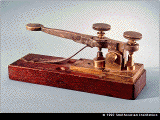
 1844: government-funded testbed links Baltimore
and Washington (37 miles). Sends the famous message: "What hath God
wrought?" Morse wanted to establish a government-owned telegraphy system
in the United States. Congress refused, and suggested that he develop the
system with the financial banking of the private sector. Sharp contrast
to the rest of the world, where the telegraphy system was absorbed into
postal systems administered by national governments.
1844: government-funded testbed links Baltimore
and Washington (37 miles). Sends the famous message: "What hath God
wrought?" Morse wanted to establish a government-owned telegraphy system
in the United States. Congress refused, and suggested that he develop the
system with the financial banking of the private sector. Sharp contrast
to the rest of the world, where the telegraphy system was absorbed into
postal systems administered by national governments.
The International Telegraphy Union developed from the need to transmit telegrams across national boundaries.
1852: First transnational telegram. Telegram originated in Paris reached the French border with the German Principality of Baden. Translated from French into German, rowed across the Rhine, and retransmitted along Baden's telegraphic lines!
The world's first permanent international organization: the International Bureau of Telegraph Administrations, founded in Berne Switzerland in the late 1860s. Regulated international telegraphy rates, and established the framework in which telegraphy systems could be joined across national boundaries.
European governments, rather than private enterprise, control the telegraph lines. This had some serious political implications: it was not desirable for diplomatic telegrams to be sent from London to St. Petersburg via Germany's state controlled telegraph network at this time. Deployment of telegraphic lines around the world driven by the need of the European powers to communicate with their colonies.
New technologies needed to be developed to bridge water. Lieutenant in the Prussian Artillery named Siemens invented a machine to coat telegraphy cables with latex rubber, and he was the first to deploy telegraph cables across the Rhine.
 Transoceanic telegraph cables
very high risk venture in the middle of the 19th Century.
Transoceanic telegraph cables
very high risk venture in the middle of the 19th Century.
1858: Cyrus Field lays first transatlantic cable. President Buchanan and Queen Victoria exchanged the first transatlantic telegrams (August 14). Line failed within a few months: overzealous operator injects too much current, causes insulation to break down.
Long cables act like a distributed capacitance, damping out electrical impulses as they travel along the cable. Professor William Thompson, later Lord Kelvin, analyzed the problem and developed very sensitive detection equipment (mirror galvanometer).
1866: New transatlantic cable was laid (using the world's largest ship at the time, the Great Eastern), and this one operated continuously. Heart's Content, Newfoundland to Valentia, Ireland.
Rapidly expanding telegraphic network that reached every corner of the globe. By 1870, Great Britain communicates directly with North America, Europe, the Middle East, and India, through the "pink bits" of the map of the world.
1850s: Reuthers sets up the "Telegraph News Network" in London exploiting Great Britain's telegraph dominance.
1861: Between July 4 and October 24, Western Union constructs a telegraph line from St. Joseph, MO to Sacramento, CA. Puts the Pony Express out of business. Operated until 1869, when replaced by multiwire system that follows the transcontinental railway.
Other nations scrambled to duplicate Britain's global reach; no nation could trust its critical command messages to the telegraphic lines of a foreign power. E.g., during a crisis in French Indochina in 1893, dispatches from Paris to its commanders in Southeast Asia held up by the British-owned Eastern Telegraphic Company until they could be read by the British Cabinet! So much for the statement that "gentlemen do not read each others mail."
 Professor at Glasgow University,
held the Chair of Natural Philosophy at age 22.
Professor at Glasgow University,
held the Chair of Natural Philosophy at age 22.
Fundamental contributions to thermodynamics (Kelvin is a unit a temperature on the scale where absolute zero = 0).
Mirror galvanometer made possible reliable signaling across the Atlantic.
Baud: unit of transmission bandwidth ("a 9600 baud modem")
1870s: Invented 5 unit code: any letter of the alphabet encoded as a unique symbol in a 5-unit set. Operator has a keyboard with 5 keys, representing the 5-unit code for each letter of the alphabet.
Question: how large an alphabet can be captured by the 5-unit code?
Time division multiplexing: multiplex multiple messages in progress at the same time over a single wire.
